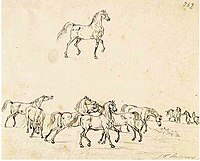Johann Friedrich Steinkopf (painter)
Johann Friedrich Steinkopf (born March 5, 1737 in Oppenheim , † January 30, 1825 in Stuttgart ) was a German porcelain painter, animal painter and landscape painter.
Life
Johann Friedrich Steinkopf was born as the third of 5 children on March 5, 1737 in Oppenheim am Rhein. His father was the master butcher Carl Otto Steinkopf (1730–1779). His mother was Anna Elisabeth Finkenauer († 1773), the daughter of a lawyer school.
Early years
After attending Latin school, Steinkopf, despite his inclination towards classical literature and art, had to take up a job in a Mannheim grocery store at the behest of his father at the age of 14. When his cousin fell ill, the 15-year-old held his post as a postman in Oppenheim for a year, which involved looking after 40 horses.
Porcelain painter
He then joined the porcelain factory founded by Paul Hannong in Frankenthal shortly before in 1755 . The artistically precocious boy soon became a skilled porcelain painter. Feeling badly treated by his superiors, he left the factory after finding a job in the porcelain factory in Ludwigsburg founded in 1758 by Duke Karl Eugen von Württemberg . Numerous pieces marked with an S (usually red) from the heyday of the factory are ascribed to him, namely plates and platters with equestrian fights and hunting scenes.
In 1770 Steinkopf married Katharina Barbara Betulius (1754–1816), a daughter of the master bookbinder, antiquarian and publisher Johann Christoph Betulius (1728–1791). The marriage had 14 children, including the publisher Johann Friedrich Steinkopf (1771–1852), the pastor Carl Friedrich Adolf Steinkopf (1773–1859), the painter Gottlob Friedrich Steinkopf (1779–1861) and the antiquarian Ferdinand Steinkopf (1787– 1828). Since Steinkopf's family grew rapidly, but the factory paid its staff irregularly and often only with porcelain, Steinkopf gave up his position around 1775 and moved to Stuttgart.
Stuttgart
In Stuttgart Steinkopf earned his living with private lessons in drawing and practiced oil painting by copying works by the Dutch battle and landscape painter and excellent horse painter Philips Wouwerman and the animal painter Johann Heinrich Roos . When an apprenticeship for freehand drawing was established at the Stuttgart grammar school in 1786, he accepted it and held it until his retirement in 1817. In 1801 Duke Friedrich, who later became King Friedrich, appointed him court painter for animal painting. For the farm, Steinkopf created numerous horse and cattle pieces in oil based on nature in a scenic setting.
Steinkopf died at the age of almost 88 on January 30, 1825 in Stuttgart, his wife died in 1816 at the age of 61. Mainly by exchanging his drawings with art dealers, Steinkopf acquired a collection of drawings, pictures and engravings that were auctioned off after his death. The printed sales catalog consisted of 80 pages.
|
|
reception
According to the judgment of the art writer August Wintterlin , his works show Steinkopf “as a good observer and skilled draftsman who, undeterred by the constraints of Classicism, went his own way by the hand of nature and the Dutch, without revealing too often to the autodidact . The former porcelain painter remained pleasantly visible in the extremely fine tones of his watercolors. "
literature
- Bertold Pfeiffer: The Ludwigsburg porcelain factory. In: Württembergische Vierteljahrshefte für Landesgeschichte, New Series Volume 1, 1892, pages 241–293, here: 271, pdf .
- Georg Kaspar Nagler: New general artist lexicon. Volume 17, Munich: Fleischmann, 1847, pages 292–293 (reprint of #Steinkopf 1826.1 ).
- Max Schefold: The Steinkopf family of artists from Württemberg. In: Journal of the German Association for Art Research, Volume 6, 1939, pages 131–161.
- Gottlob Friedrich Steinkopf: Johann Friedrich Steinkopf. In: Morgenblatt für educated estates, 1826, pages 323-324, pdf .
- Directory of the collection of oil paintings, hand drawings, copperplate engravings and works of art, which are for sale from the estate of the royal Württemberg court painter JF Steinkopf. Stuttgart, 1826.
- From the Steinkopf family chronicle. A commemorative sheet for August 1, 1898. Stuttgart: JF Steinkopf, 1898, page 8, 86–87.
- Otto Wanner-Brandt; Bertold Pfeiffer: Album of the products of the former Württemberg manufactory Alt-Ludwigsburg. Stuttgart, 1906, pages 13, 15, pdf .
- August Wintterlin: Steinkopf, Johann Friedrich . In: Allgemeine Deutsche Biographie (ADB). Volume 35, Duncker & Humblot, Leipzig 1893, pp. 736-739.
- August Wintterlin: Württemberg artists in life pictures. Stuttgart: Deutsche Verlags-Anstalt, 1895, pages 25–28.
Web links
Footnotes
- ↑ # Steinkopf 1898 .
- ↑ #Wintterlin 1893 , pp. 736-737.
- ↑ #Wintterlin 1893 , page 737.
- ↑ #Wintterlin 1893 , page 737.
- ↑ # Steinkopf 1826.2 .
- ↑ #Wintterlin 1893 , page 737.
| personal data | |
|---|---|
| SURNAME | Steinkopf, Johann Friedrich |
| BRIEF DESCRIPTION | German porcelain painter, animal painter and landscape painter |
| DATE OF BIRTH | March 5, 1737 |
| PLACE OF BIRTH | Oppenheim |
| DATE OF DEATH | January 30, 1825 |
| Place of death | Stuttgart |



